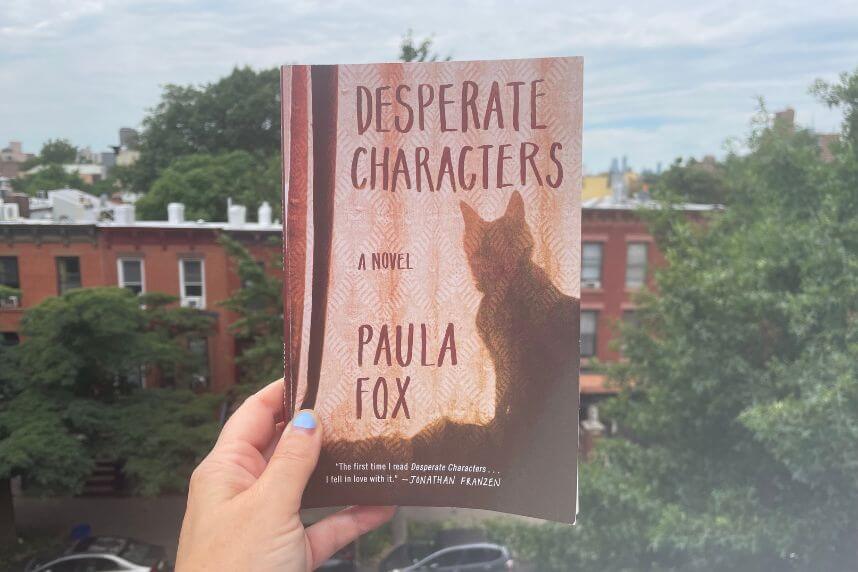Revisiting ‘Desperate Characters’

“Desperate Characters” by Paula Fox remains as relevant today as the day it was published. Photo: Meredith Craig de Pietro
This story is part of our “Brooklyn Classics” series about famous and underappreciated books set in the borough.
Paula Fox wrote Desperate Characters over 50 years ago, but the book remains as impactful now as it was then. Part of Brooklyn’s literary canon, it’s about a fraying marriage set against the backdrop of gentrification, a topic that is still front of mind for most of us living in the city as rental prices soar.
The story centers on an estranged couple, Otto and Sophie Bentwood, who live in a brownstone in an unnamed neighborhood that reads as our current Boerum Hill/Cobble Hill. After a stray cat bites Sophie on the hand, she believes she may have rabies, and her throbbing, swollen wound becomes a stand-in for the changing and unsafe city around them. The Bentwoods’ world takes place in seedy, 1960s New York, a chaotic place where they’re trying to lay down a stable middle-class life among the garbage-strewn streets. Otto is a lawyer who has just dissolved his company with his more liberal-minded partner, while Sophie is a translator who doesn’t take on much work and remains bored and listless, refusing even to go to the doctor to determine if she has rabies.
The double fears of gentrification and disease ring true for today’s readers, but Fox examines the Brentwoods from an unsettling perspective. We aren’t meant to identify with the couple as much as hold them up to the light. As the chaos, poverty, and violence of the “outside world” reaches inside their well-manicured houses (one in Brooklyn and one on Long Island,) the couple’s value system starts to break down, too. “God, if I am rabid, I am equal to what’s outside,” Sophie says to herself in the novel, “and felt an extraordinary relief…”
The title of the book comes from a passage in Henry David Thoreau’s ‘Walden’
“The mass of men lead lives of quiet desperation. What is called resignation is confirmed desperation.” —Henry David Thoreau, Walden
The title works in the context of the book, but unfortunately reads more like chick-lit. Perhaps this is why Fox never received the same acclaim as her literary contemporaries like John Updike and Philip Roth.
Jonathan Franzen — who called the book “simply one of the greatest novels ever written by an American” — points out the problem in an introduction to the book’s 1999 reissue. “[The title is] apt, certainly, and yet it’s no The Day of the Locust, no The Great Gatsby, no Absalom, Absalom! It’s a title that people may forget or confuse with other titles,” he writes. (Side note: Six of Fox’s books were out of print until 1999, after Franzen picked up Desperate Characters at the artist’s colony Yaddo and mentioned the book in his Harper’s essay on realism. Sigrid Nunez, also at Yaddo at the time, recommended it to him.)
Paula Fox’s granddaughter is Courtney Love.
Paula Fox, who died in 2017 at the ripe age of 93, discusses her life in her memoir, Borrowed Fineries. Her childhood was tragic; she was given up for adoption by her mother, then brought home by her grandmother and passed around to relatives until she was old enough to fend for herself. She lived with the acting coach Stella Adler and was friends with Marlon Brando, and there are rumors she had a child with Brando, although those were never confirmed. She gave that baby girl up for adoption, and the baby grew up to be Linda Carroll, a psychotherapist/author and mother of rock star Courtney Love. Carroll hired a detective to find Fox later in life, and though Fox says she became close with her daughter, she was not enamored with her granddaughter. She and Love met only once over lunch, and according to the New Yorker, it did not go well.
Fox didn’t write her first book until she was in her 40s and became primarily known as a children’s author. When she was in her 70s, she was mugged in Jeruselum, leading to a head injury that made it difficult to write. She published her last book, “News from the World: Stories and Essays,” in 2011.
Symbols of gentrification: then and now.
“What happens to the people in them when the houses are bought? Where do they go? I always wonder about that,” Sophie Bentwood muses in Desperate Characters. The Bentwoods live in a “powerfully solid” house which protects them from the “slums” across the way. They consider themselves to be different from those “slums”, because “each of the houses on the Bentwoods’ block was occupied by one family…Most front parlor windows were covered with white shutters.”
Although we may not see white shutters in Brooklyn very often anymore and wouldn’t recognize them as a harbinger of gentrification, we do have another symbol: the gentrification font. In 2020, Vice writer Bettina Makalintal examined those ubiquitous sans serif house numbers that signify a changing neighborhood. University of Arizona professor Jonathan Jae-an Crisman called the font “generic authentic” and linked its rise with people looking for cheap ways to flip houses following the Great Recession. And although it is true, as Makalintal notes, that “gentrification is not an aesthetic but a systematic process of displacement,” it is also true that these numbers say something about the people living in these places, and the performative aspect of what they hope to show others.
Fox explained it well: “What the owners of the street lusted after was recognition of their superior comprehension of what counted in this world, and their strategy for getting it combined restraint and indirection.” Fifty years later, nothing has changed.
The post Revisiting ‘Desperate Characters’ first appeared on Brooklyn Based.
By: Meredith Craig de PietroTitle: Revisiting ‘Desperate Characters’
Sourced From: brooklynbased.com/2022/08/11/revisiting-paula-fox-desperate-characters/
Published Date: Thu, 11 Aug 2022 14:29:59 +0000

Comments
Post a Comment